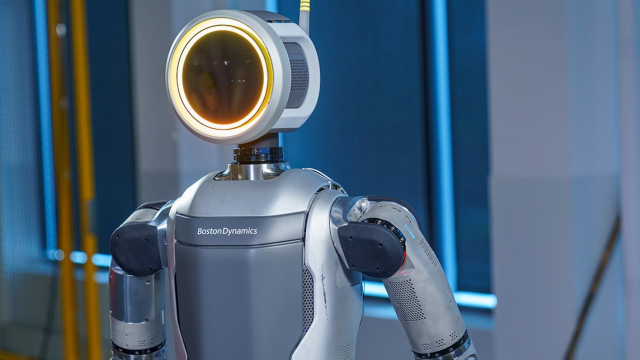Atlas the robot was killed off yesterday, only to rise from the dead today. So don’t write off the robot uprising just yet.
Boston Dynamics released a video on Tuesday announcing the retirement of Atlas, the most famous humanoid robot in the world. But eagle-eyed observers noticed something curious in the announcement. The description in Atlas’s retirement video said the hydraulic Atlas was going away. And skeptics were right to take notice of that word. Because a new form of Atlas—all electric this time—makes a brief appearance in a new video.
The new video, which showed up on YouTube Wednesday, is just half a minute long.
“The electric version of Atlas will be stronger, with a broader range of motion than any of our previous generations,” Boston Dynamics said in a blog post. “For example, our last generation hydraulic Atlas (HD Atlas) could already lift and maneuver a wide variety of heavy, irregular objects; we are continuing to build on those existing capabilities and are exploring several new gripper variations to meet a diverse set of expected manipulation needs in customer environments.”
Boston Dynamics also explained how the company was partnering with Hyundai to build “the next generation of automotive manufacturing capabilities.” While the details of that business relationship are still scarce, other carmakers have started putting humanoid robots to work in their factories. BMW, for instance, has partnered with Figure, one of the most exciting robotics startups around. And then there’s Tesla, which is trying to build its own humanoid robot, even if it’s currently way behind the competition.
Arguably the most interesting tidbit in the latest announcement from Boston Dynamics includes hints that Atlas might start to move in decidedly non-human ways. And the video clearly hints at that with the rather dramatic new contortions of Atlas.
“Traditionally, we have focused on legged robots because we wanted to build robots that could balance and move dynamically—robots that could navigate unstructured, unknown, or antagonistic terrain with ease. The humanoid form factor is a useful design for robots working in a world designed for people,” Boston Dynamics said. “However, that form factor doesn’t limit our vision of how a bipedal robot can move, what tools it needs to succeed, and how it can help people accomplish more.”
As we pointed out on Tuesday, the most exciting advancements in Atlas over the years were the times when he wasn’t just matching what the average human could do, but exceeding those capabilities. When Atlas was doing backflips it was impressive because most humans can’t do that. And Boston Dynamics clearly understands this is why robots are exciting.
“We designed the electric version of Atlas to be stronger, more dexterous, and more agile. Atlas may resemble a human form factor, but we are equipping the robot to move in the most efficient way possible to complete a task, rather than being constrained by a human range of motion. Atlas will move in ways that exceed human capabilities,” Boston Dynamics said.
Yes, that can seem ominous. But welcome to the world of robotics. This shit is always going to be terrifying when it’s done right.
